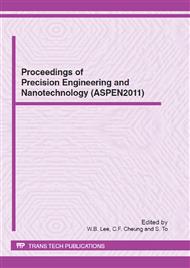p.251
p.257
p.263
p.269
p.275
p.281
p.287
p.293
p.299
Experimental Verification of Machining Process of Ultrasonic Drilling
Abstract:
Drill processing of difficult-to-cut materials such as ceramics, hardened steel, glass and heat-resistant steel is widely required in the industrial world. Furthermore the drilling process becomes more and more difficult in the case of hole diameters less than one millimetre. In order to achieve the requirements for the drilling process, ultrasonically assisted machining is applicable. Ultrasonic vibration assisted machining techniques are suitable for machining difficult-to-cut materials precisely. However, the cutting process of ultrasonic drilling has not been clarified. It is difficult to observe directly the effect of vibration. The aim of this study is to observe the dynamic, instantaneous and micro cutting process. In this report, a high-speed camera with a polarized device, which is appropriately arranged, realized the visualization of the process of ultrasonic drilling based on photoelastic analysis. For conventional drilling, the stress distribution diagram showed that the intensive stress occurred in limited areas under the chisel because the chisel edge of the drill produces large plastic deformation. On the other hand, the ultrasonic drilling produced spread stress distribution and a stress boundary far away from the chisel. The photoelastic analysis showed the explicit difference of drilling processes.
Info:
Periodical:
Pages:
275-280
Citation:
Online since:
June 2012
Authors:
Price:
Сopyright:
© 2012 Trans Tech Publications Ltd. All Rights Reserved
Share:
Citation:


